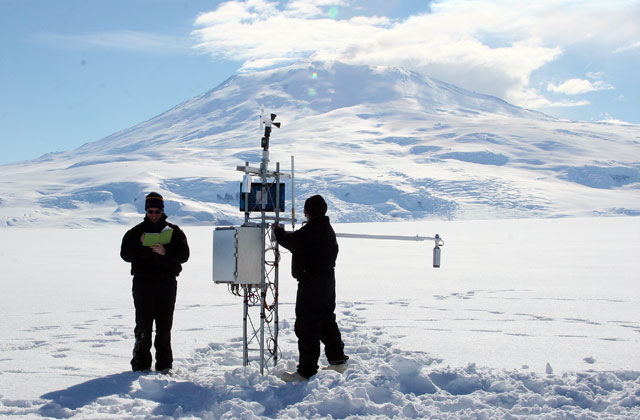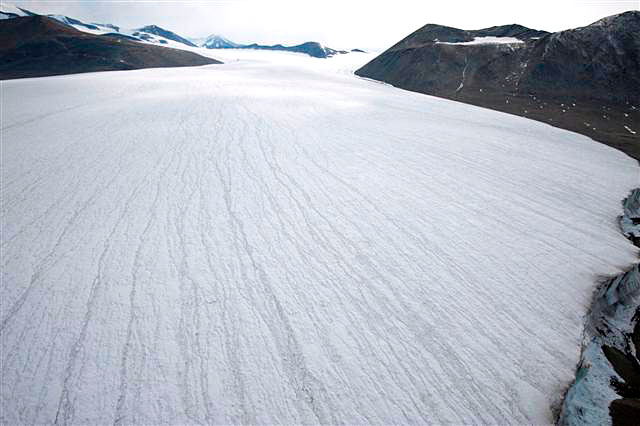Record extent2010 climate report notes Antarctic sea ice grows while world warmsPosted July 15, 2011
By all accounts, 2010 was a rough — and hot — year on the planet. In fact, last year was one of the two warmest years on record, matching the record year in 2005, according to the 2010 State of the Climate report The peer-reviewed report, issued in coordination with the American Meteorological Society The big story out of Antarctica involved sea ice. But unlike in the Arctic, where sea ice extent is shrinking over the last decade, winter sea ice in Antarctica reached a record extent in 2010 thanks to a persistently strong atmospheric circulation pattern called the Southern Annular Mode that locked in the cold. Sea ice responds to colder temperatures by growing more. 
Photo Credit: Jeff Scanniello/Antarctic Photo Library
Broken plates of sea ice float in McMurdo Sound.
The positive growth of total sea ice extent around Antarctica, which averages 18 million square kilometers at the height of winter, is part of a long-term trend and is consistent with how scientists believe climate change affects the southernmost continent, according to Ryan Fogt “It’s consistent with the way the atmospheric circulation is changing around Antarctica, which we do believe is evidence of climate change,” said Fogt, whose research, like many contributors to the report, is partly funded by the National Science Foundation (NSF) Sea ice is an important feature of the Earth’s climate system because it reflects solar energy back into space. The loss of sea ice in the Arctic is problematic, in part, because less reflective cover means more solar energy is absorbed by the dark ocean, which raises temperatures. In turn, that melts more sea ice, allowing more solar energy to reach the surface in a positive feedback loop. Fogt said that in 2010 Antarctica’s sea ice extent was about 250,000 square kilometers greater than the 1979-2008 average during most of July and August. “The second half of 2010 was a pretty large year for growth of the Antarctic sea ice overall, but there were still regions that experienced some reductions,” he said. In particular, sea ice losses were experienced in the Bellingshausen and Amundsen seas regions. The Amundsen Sea is home to West Antarctica’s Pine Island Glacier, which a recent report said has increased its melt rate by 50 percent in the last 15 years. [See previous article: Speeding up.] The Bellingshausen Sea abuts the western edge of the Antarctic Peninsula, which is one of the fastest warming regions on the planet. Since the 1950s, the average winter temperature has spiked by 6 degrees centigrade, reducing the duration of sea ice in the area by three months. Above-average temperatures continued to reign along the Antarctic Peninsula in 2010 from May to December, according to the report. And it wasn’t the only place that heated up last year. “In fact, some parts of Antarctica that have been quite cold, or where we’ve seen some cooling trends, such as in East Antarctica and over the South Pole, were not as cold in 2010,” Fogt said. “Some of the long-term cooling trends there were reduced dramatically by 2010 temperatures, especially during the early part of the year.” Fogt’s grant from NSF’s Office of Polar Programs However, despite the warming in West Antarctica and the Antarctic Peninsula, the positive trend in Antarctic-averaged sea ice extent is expected to continue into the immediate future. But recent studies and reports suggest it’s only a matter of time before the build-up of greenhouse gases in the atmosphere catches up and begins to heat up enough to reduce sea ice formation. [See previous articles: State of the Antarctic and Maximum extent.] Incidentally, the NOAA report noted that carbon dioxide levels increased at a faster rate in 2010 than in 2009 and also faster than the average rate over the past 30 years. The connectedness of Antarctica’s climate to the rest of the globe has only recently been understood by scientists, partly because of the dearth of observations around the continent, according to Fogt. “It’s only within the last decade or so … that we’ve really started to understand how these large-scale climate features affect the continent,” he said. “Antarctica is just a little behind the rest of the globe in understanding it because of [the] lack of spatially complete data.” NSF-funded research in this story: Ryan Fogt, Ohio University, Award No. 0944168 |



For USAP Participants |
For The Public |
For Researchers and EducatorsContact UsNational Science FoundationOffice of Polar Programs Geosciences Directorate 2415 Eisenhower Avenue, Suite W7100 Alexandria, VA 22314 Sign up for the NSF Office of Polar Programs newsletter and events. Feedback Form |



